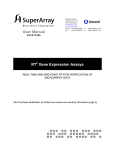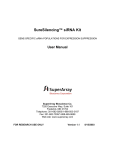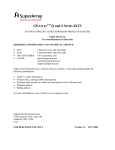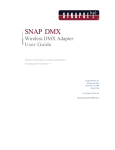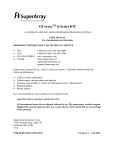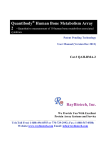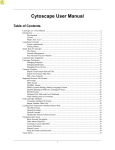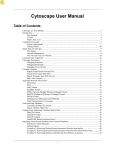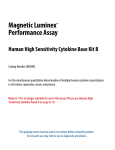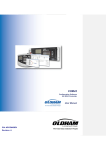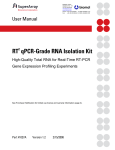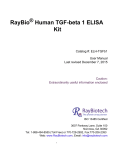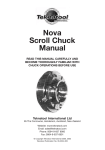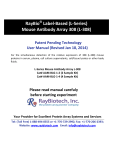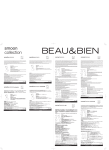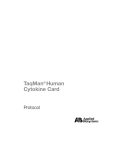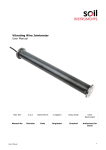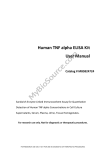Download Mouse Cytokine-II MultiGene-12™ RT-PCR Profiling Kit Cat. No. PM
Transcript
Mouse Cytokine-II MultiGene-12™ RT-PCR Profiling Kit Cat. No. PM-008A Description The Mouse Cytokine-II MultiGene-12™ RT-PCR Profiling Kit is designed to monitor the expression levels of the cytokine genes listed below. The regulation of cytokine expression plays a fundamental role in the development and function of the immune system. Cytokines are secreted by immune cells and bind to their cognate receptors on the surface of another cell. The ability to secrete particular cytokines gives a cell the ability to signal to particular cells or initiate or propagate certain cascades. Each MultiGene-12TM RT-PCR Profiling Kit contains 8 identical strips of 12 PCR tubes. Each PCR tube contains a pair of gene-specific primers that is carefully designed and tested by SuperArray Bioscience. The kit also includes 8 tubes of ReactionReady™ PCR master mix 1000, a lyophilized master mix for end-point analysis by agarose gel electrophoresis. Kit Contents Component ReactionReady™ PCR master mix 1000 MultiGene-12™ Primer Strips Gene List Tube 1 2 3 4 5 6 7 8 9 10 11 12 Gene Name Interleukin 16 Interleukin 17D Interleukin 18 Interleukin 19 Interleukin 25 Interferon gamma Csf2 Mif Transforming growth factor, beta 1 Tgfb3 Lymphotoxin A GAPDH Amount 8 tubes each enough for 12 reactions 8 strips of 12 PCR tubes containing primers RT-PCR Product Expected size (bp)* 473 439 462 517 451 391 534 411 Gene Symbol UniGene # GenBank Accession # Il16 Il17d Il18 Il19 Il25 Ifng Csf2 Mif Mm.10137 Mm.3409 Mm.1410 Mm.131480 Mm.29925 Mm.529 Mm.4922 Mm.2326 NM_010551 NM_145837 NM_008360 AF453945 NM_080837 AK089574 NM_009969 NM_010798 463 Tgfb1 Mm.9154 NM_011577 393 458 419 Tgfb3 Lta Gapd Mm.3992 Mm.87787 Mm.5289 NM_009368 NM_010735 NM_008084 * The actual size of the observed bands may vary (or multiple bands may appear in the same sample) if splice variants of a particular message exist in your experimental RNA sample. Related Products from SuperArray Bioscience: 1. ReactionReady™ First Strand cDNA Synthesis Kit C-01 2. GEArray™ Q Series Mouse Cytokine and Inflammatory Response Arrays 3. MultiGene-12™ Mouse Cytokine-I RT-PCR Profiling Kit 4. SureSilencing™ siRNA Kits MultiGene-12™ RT-PCR Profiling Kit PATHWAY-SPECIFIC RT-PCR GENE EXPRESSION PROFILING SYSTEMS User Manual SuperArray Bioscience Co. 7320 Executive Way, Suite 101 Frederick, MD 21704 Telephone: 301-682-9200/1-888-503-3187 Fax: 301-682-7300/1-888-465-9859 Web site: www.superarray.com FOR RESEARCH USE ONLY Version 1.1 8/15/2003 SuperArray MultiGene-12™ RT-PCR Profiling Kit User Manual Version 1.1 8/15/2003 MultiGene-12™ RT-PCR Profiling Kit PATHWAY-SPECIFIC RT-PCR GENE EXPRESSION PROFILING SYSTEMS USER MANUAL ORDERING INFORMATION AND TECHNICAL SERVICE • • • • TEL: FAX: ON-LINE ORDER: E-MAIL: 1-888-503-3187, 301-682-9200 1-888-465-9859, 301-682-7300 www.superarray.com [email protected] [email protected] [email protected] Orders may be placed by fax, e-mail or from our website. Each order should include the following information: • • • • • Caller’s contact information Product name, catalog number and quantity Purchase order number or credit card information (Visa or MasterCard) Shipping address Billing address For more information, visit us at http://www.superarray.com SuperArray Bioscience Corp. 7320 Executive Way, Suite 101 Frederick, MD 21704 USA 2 SuperArray MultiGene-12™ RT-PCR Profiling Kit User Manual Version 1.1 8/15/2003 3 TABLE OF CONTENTS I. Background and Introduction 4 II. Kit Contents / Materials Provided 6 III. Additional Materials Required 6 IV. Protocol Appendix A: RT Reaction for USA Customers Appendix B: RT Reaction for International Customers 7 9 10 V. Troubleshooting Guide 11 LIMITED PRODUCT WARRANTY This product is intended for research purposes only and is not intended for drug or diagnostic purposes or for human use. This warranty limits our liability to replace this product in the event the product fails to perform due to any manufacturing defect. SuperArray Bioscience Corporation makes no other warranties of any kind, expressed or implied, including without limitation, warranties of merchantability or fitness for a particular purpose. SuperArray Bioscience Corporation shall not be liable for any direct, indirect, consequential or incidental damages arising out of the use, the results of use or the inability to use this product. NOTICE TO PURCHASER The purchase of MultiGene-12™ RT-PCR Profiling Kit products includes a limited, nonexclusive license to use the kit components for research use only. This license does not grant rights to use the kit components for reproduction of any primer pair mix, to modify kit components for resale or to use MultiGene-12™ RT-PCR Profiling Kits to manufacture commercial products without written approval of SuperArray Bioscience Corporation. No other license, expressed, implied or by estoppel, is granted. U.S. patents may cover certain isolated DNA sequences included in the MultiGene-12™ RT-PCR Profiling Kit. Presently, it is not clear under U.S. laws whether commercial users must obtain licenses from the owners of the rights to these U.S. patents before using MultiGene-12™ RT-PCR Profiling Kits. SuperArray MultiGene-12™ RT-PCR Profiling Kit User Manual Version 1.1 8/15/2003 4 I. BACKGROUND AND INTRODUCTION The advancement of nucleic acid array technology has made it possible to analyze the expression of multiple genes in a single experiment. However, changes in the expression of genes observed by array analysis must still be verified by an independent method such as Northern or RT-PCR analysis. Only one gene can be analyzed by Northern analysis at one time in any given experiment making it difficult to characterize gene expression in a high throughput manner. Multiple RT-PCR analyses can be performed at one time with the 96-well blocks built into most thermal cyclers. However, the design of specific primers for several genes with the same annealing temperature can be difficult, tedious, time-consuming and expensive. Taking advantage of our optimized, proprietary gene-specific primers and our long in-house gene list from producing pathway-specific gene expression arrays, we have developed the MultiGene-12™ RT-PCR Profiling Kits that allow researchers to determine the relative expression of eleven genes in up to eight experimental samples at once. The primers and reagents have been formatted in a way to make the kit easy to use, economical, and accessible for routine use in every research laboratory. Each MultiGene-12™ RT-PCR Profiling Kit contains eight identical strips of 12 PCR tubes. Each tube in a strip contains a forward and reverse primer set for a specific gene. The strip represents a very focused set of eleven closely related genes from a specific biological pathway. The twelfth tube contains primers for a housekeeping gene to control for RNA loading. The primers have been immobilized on the bottom of the tubes to allow ambient temperature shipping and easy re-suspension into PCR buffer. The primers are visible as an orange spot on the bottom of the tube. Eight tubes of a pre-formulated master mix for PCR are also included in the kit as a lyophilized powder, again for ambient temperature shipping. To complete the RT-PCR analysis, experimental RNA samples must also be converted to first strand cDNA, the template for the polymerase chain reaction. We offer a kit, sold separately (Catalog Number C-01) for this step of this procedure. Features of the MultiGene-12™ RT-PCR Profiling Kit: Profiles eleven closely-related genes in a single analysis Processes up to eight different experiments at once Contains carefully designed and tested gene-specific primer sets Provides a simple way to multiplex your RT-PCR analyses SuperArray MultiGene-12™ RT-PCR Profiling Kit User Manual Version 1.1 8/15/2003 Overview of MultiGene-12™ RT-PCR Profiling Kit Procedure ReactionReady™ PCR master mix 1000 P-1000A Forward and Reverse Primer Sets for Individual Genes aliquot Experiments Experimental RNA 1 2 3 4 5 6 7 8 C-01 37 oC, 60 min ReactionReady™ First Strand cDNA Synthesis Kit PH-nnn or PM-nnn PCR < 30 min Product Characterization Agarose Gel Electrophoresis ~ 40 min Image Acquisition And Data Analysis < 30 min 5 SuperArray MultiGene-12™ RT-PCR Profiling Kit User Manual Version 1.1 8/15/2003 6 II. Material Provided: ReactionReady™ PCR master mix 1000 (P-1000A) for end-point analysis Eight tubes containing enough lyophilized PCR master mix for 12 reactions each. MutliGene-12™ Primer Strips Eight strips of 12 PCR tubes, each tube containing a set of immobilized forward and reverse primers for a specific gene. See included product sheet for the specific genes included in this kit. III. Additional Materials Required: A. RNA Isolation Kit (See Protocol Section for suggestions.) B. Reverse Transcription (RT) Reaction: OPTION 1: ReactionReady™ First Strand cDNA Synthesis Kit (C-01) – See Appendix A OPTION 2: The individual components listed below – See Appendix B Reagent Random Primers RNase Inhibitor Reverse Transcriptase dNTPs Product Promega Catalog # C1181 Promega Catalog # N2511 Promega Catalog # M1701 Promega Catalog # U1330 Kit component Buffer P Component RI Component RE C. 100-bp DNA Step Ladder (Promega Catalog Number G695A) D. The following equipment will also be necessary to use this kit: 1. Thermal Cycler 2. Agarose gel electrophoresis equipment (and reagents) 3. UV Trans Illuminator and high-speed or CCD camera SuperArray MultiGene-12™ RT-PCR Profiling Kit User Manual Version 1.1 8/15/2003 7 IV. Protocol: 1. Cell Lysis / RNA Isolation Total RNA prepared using commercially available kits is suitable for MultiGene-12™ RT-PCR gene expression profiling analysis. Total RNA prepared by Trizol Reagent (Invitrogen/Life Technologies, Cat. No. 15596-018), RNeasy mini kits (Qiagen, Cat. No. 74104) or RNAqueous (Ambion, Cat. No. 1911, 1912, or 1913) gives good results. We use the Qiagen RNeasy mini kits for our QC protocol. Total RNA should be dissolved in RNase-Free H2O at a concentration of 1.0 mg/ml. 2. RT Reaction: This step must be performed using a kit or reagents NOT included with the MultiGene12™ RT-PCR Profiling Kit. USA Customers may order the ReactionReady™ First Strand cDNA Synthesis Kit (Catalog Number C-01) and follow the protocol found in Appendix A. USA Customers may also order the individual components listed in the Additional Materials Required section and follow the protocol found in Appendix B instead. Customers outside the USA must order the individual components listed in the Additional Materials Required section and follow the protocol found in Appendix B. The C-01 kit is available in some international territories, and the protocol in Appendix A may be used. Please contact your local distributor for availability. Note: In order to take advantage of the Housekeeping MultiGene-12™ RT-PCR Profiling Kits, two separate RT Reactions must be performed for each RNA sample. One reaction will be used for a pathway-specific MultiGene-12™ primer strip, and the other will be used for the Housekeeping MultiGene-12™ primer strip. 3. MultiGene-12™ PCR a. PCR Cocktail: Transfer each completed 20 µl RT Reaction into separate tubes of ReactionReady™ PCR master mix 1000. Add 300 µl of ddH2O. Allow the lyophilized components to dissolve for a few minutes by vortexing gently. b. Dispense 25 µl of a single PCR Cocktail (ReactionReady™ PCR master mix 1000 combined with RT Reaction) to each of the 12 PCR tubes of the same MultiGene-12™ Primer Strip. Close the tubes with their caps. Mix by gently flicking the bottom of each tube. c. Place the strip on ice while setting up the PCR program: 94 °C, 5 min; 30* cycles of (94 °C, 30 sec; 50 °C, 30 sec; and 72 °C, 45 sec) * The PCR cycle number should be optimized for each experiment. Try using 30 cycles at first. The number of cycles can be decreased to 15 or increased to 45. (See Troubleshooting Guide.) Place the strips in the PCR block and run the program. SuperArray MultiGene-12™ RT-PCR Profiling Kit User Manual Version 1.1 8/15/2003 8 4. Product Characterization: a. When the PCR is complete, load 10 µl of each reaction into separate wells of a 1% agarose gel containing 0.5 µg/ml ethidium bromide in 1X TAE. NOTE: No gel loading dye or buffer is required. The ReactionReady™ PCR master mix 1000 already contains gel-loading dye. b. Load an appropriate amount of 100-bp DNA Step Ladder (Promega G695A) in an adjacent lane. c. Electrophorese in 1X TAE at 80V for 40 min. Note: The gel dye runs at a size of 50 bp under these conditions. d. Capture an image of the gel on a UV Trans Illuminator using a CCD camera or on high-speed film. The individual product information sheets list the expected sizes of the PCR products. 5. Image Acquisition and Data Acquisition and Analysis: a. Image Acquisition At this time, we highly recommend using a CCD camera to capture the image of the gel because the Data Acquisition will be more straightforward and the resulting data will have a wider dynamic range. A high-speed photograph can be used; however, the image must be digitized by other means, separate software must be used, and the dynamic range will be smaller. b. Data Acquisition If a CCD camera was used to capture the image of the gel, the software accompanying the instrument should be able to convert the image of the bands into data. Follow the instructions for that software. If relying on a high-speed photograph of the gel, digitize the image of the gel using a desktop scanner to obtain a TIFF file of the image. To convert that image into data, we then recommend using the software “NIH IMAGE” (Available free from the NIH. See the following web page and its links for more information: http://rsb.info.nih.gov/nih-image/). Follow the instructions for that software. c. Data Analysis During Data Acquisition, remember to use the software to determine an appropriate background value. That is, use the same rectangle or other shape used to surround the gel bands to surround a blank area of the gel and obtain data from that area. Subtract that background value from the integrated intensity values of all other data points obtained from the gel bands. Finally, divide each of the background-corrected values by the background-corrected value for the GAPDH housekeeping gene. These normalized values can then be compared between experimental conditions. For example, fold changes in gene expression can be calculated. SuperArray MultiGene-12™ RT-PCR Profiling Kit User Manual Version 1.1 8/15/2003 9 Appendix A: RT Reaction for USA Customers Using ReactionReady™ First Strand cDNA Synthesis Kit (Catalog Number: C-01) Note for customers outside the USA: For your convenience, an alternative RT Reaction protocol using the recommended components from other manufacturers (See the Materials Provided section.) is described in Appendix B. 2. RT Reaction: a. Prepare the Annealing Mixture: For each RNA sample, combine the following into a sterile PCR tube: Total RNA 1.0 to 5.0 Buffer P 1.0 RNase-free H2O to a final volume of 10.0 µg µl µl Mix the contents gently with a pipettor followed by brief centrifugation. Place the mixture in a thermal cycler at 70 °C for 3 min. Cool to 37 °C and keep at that temperature for 10 min. b. Prepare the RT Cocktail: This mixture can be prepared while the Annealing Mixture is incubating at 37 °C. RT Cocktail Buffer BC (5X RT Buffer) RNase-free H2O RI (RNase Inhibitor) RE (Reverse Transcriptase) Final Volume 1 reaction 4 µl 4 µl 1 µl 1 µl 10 µl 2 reactions 4 reactions 8 reactions 8 µl 16 µl 32 µl 8 µl 16 µl 32 µl 2 µl 4 µl 8 µl 2 µl 4 µl 8 µl 20 µl 40 µl 80 µl Warm the RT Cocktail at 37 °C for 1 min before proceeding to the next step. c. RT Reaction: Add 10 µl of RT Cocktail to each 10 µl-Annealing Mixture. Mix well but gently with a pipettor and continue incubation at 37 °C for 60 min. Heat at 95 °C for 5 min to hydrolyze the RNA and to inactivate the reverse transcriptase. Hold the finished RT Reaction on ice until the next step. Continue the MultiGene-12™ Protocol from Step 3: MultiGene-12™ PCR (page 7). SuperArray MultiGene-12™ RT-PCR Profiling Kit User Manual Version 1.1 8/15/2003 10 Appendix B: RT Reaction for Customers Outside the USA Synthesizing first strand cDNA using individual components Individual components for first strand cDNA synthesis (reverse transcription) may also be purchased separately from other manufacturers. (See the Materials Provided section of this manual.) For your convenience, the following protocol is provided for using these individual reagents to synthesize first strand cDNA to be used in the MultiGene-12™ RT-PCR Profiling Kit. Customers outside the USA need to buy their components for reverse transcription separately and follow this protocol. 2. RT Reaction: a. Prepare the Annealing Mixture: For each total RNA sample, combine the following into a sterile PCR tube: Total RNA 1.0 to 5.0 Random Primers 1.0 RNase-free H2O to a final volume of 10.0 µg µl µl Mix the contents gently with a pipettor followed by brief centrifugation. Place the mixture in a thermal cycler at 70 °C for 3 min. Cool to 37 °C and keep at that temperature for 10 min. b. Prepare the RT Cocktail: This mixture can be prepared while the Annealing Mixture is incubating at 37 °C. RT Cocktail 5X Promega Reaction Buffer 2.5 mM dNTP Mix* RNase Inhibitor MMLV Reverse Transcriptase Final Volume 1 reaction 4 µl 4 µl 1 µl 1 µl 10 µl 2 reactions 8 µl 8 µl 2 µl 2 µl 20 µl 4 reactions 8 reactions 16 µl 32 µl 16 µl 32 µl 4 µl 8 µl 4 µl 8 µl 40 µl 80 µl * Dilute 100 mM stock 1:40 with RNase-free H2O. Warm the RT Cocktail at 37 °C for 1 min before proceeding to the next step. c. RT Reaction: Add 10 µl of RT Cocktail to each 10 µl-Annealing Mixture. Mix well but gently with a pipettor and continue incubation at 37 °C for 60 min. Heat at 95 °C for 5 min to hydrolyze the RNA and to inactivate the reverse transcriptase. Hold the finished RT Reaction on ice until the next step. Continue the MultiGene-12™ Protocol from Step 3: MultiGene-12™ PCR (page 7). SuperArray MultiGene-12™ RT-PCR Profiling Kit User Manual Version 1.1 8/15/2003 11 V. TROUBLESHOOTING GUIDE & FREQUENTLY ASKED QUESTIONS Why are the sizes of my PCR products not the same as the expected size listed on the product sheet? Why do I see multiple bands in the RT-PCR product? We test each primer set using several sources of RNA and using cDNA libraries. Under these conditions, the RT-PCR product is a single band with the predicted and expected size. However, your RNA experimental sample may contain alternative splicing variants of a particular message. Each variant may produce a band of a different size in the RT-PCR reaction depending on the placement of the primer relative to the relevant splice junctions. The existence of alternative splicing products may not necessarily have been published in the literature. By the same token, a single band of the expected size from the provided primer set does not necessarily indicate a single splicing product. The single band may simply represent the dominant or major splicing product. Multiple spicing variants can also produce a single RT-PCR band if the amplified fragment lies within a single exon. Contamination of your RNA with genomic DNA may also cause the appearance of extra PCR bands. Does the gel loading dye interfere with the PCR? No. We have carefully tested the effect of the inert ingredients in the ReactionReady™ PCR master mix 1000 on the ability to obtain a PCR product. None of the added components adversely affects the reaction. How much RNA should I use for MultiGene-12™ analyses; that is, why is the range of RNA amounts recommended? The amount of RNA used can depend on how much you are able to isolate and how may different experiments you need to perform with that sample. Also, lower abundance messages may require more input RNA in order to observe an RT-PCR product. The RT-PCR can accommodate as little RNA as 1.0 µg and as much as 5.0 µg per MultiGene-12™ Primer Strip of 12 tubes. Another way to control RNA loading in a MultiGene-12™ analysis involves performing replicate analyses using the same RNA sample but different volumes of the RT Reaction. For example, the scale of the RT Reaction can be doubled, and four different MultiGene-12™ analyses can be performed adding 20, 10, 5, or 2.5 µl of RT Reaction to the four different tubes of master mix. Examination of these results will quickly reveal the appropriate amount of template needed to achieve the dynamic range of the analysis. SuperArray MultiGene-12™ RT-PCR Profiling Kit User Manual Version 1.1 8/15/2003 12 How should I optimize the number of PCR cycles in my experiment? Use a cycle number that produces signal intensities within the dynamic range of the RT-PCR method under your experimental conditions (amount of input RNA, genes being analyzed, etc.). Try not to allow any of the intensities of the gel bands to peak or saturate. Otherwise, the experimental results will not accurately reflect the relative expression of the genes. You may have to optimize the number of cycles for each experiment. Lower abundance messages will require more cycles of PCR; higher abundance messages, fewer cycles. Less input RNA may also require more PCR cycles, and more RNA, fewer cycles. In a preliminary experiment, you can perform replicate MultiGene-12™ analysis for a given RNA sample. At the end of a chosen number of cycles, remove one of the replicate strips and store it on ice until after the strip using the greatest number of cycles has been removed and you are ready to perform the gel analysis. For example, one RNA sample can be analyzed in quadruplicate, and a strip can be removed after 15, 20, 25, and 30 cycles. Why did I not see a PCR product where I expected to see one? RNA quality is the most critical factor for a successful MultiGene-12™ RT-PCR Profiling analysis. Be sure to check the quality of the RNA before use. The ratio of the absorbance readings at 260 to 280 nm should be at least 1.8, and a total RNA sample should yield two distinct bands by agarose gel electrophoresis representing the 28S and 18S ribosomal RNA molecules. Those bands should have a 2:1 intensity ratio as well. The relative expression I observe with MultiGene-12™ does not agree with my GEArray or other microarray result. An inability to achieve verification is not necessarily due to a flaw in the array experiment. Arrays may simply not be able to represent a particular gene accurately. However, RT-PCR methods are better able to accurately represent the expression level of genes. Monitoring the expression level of a large number of genes by RT-PCR is difficult; usually only a few are performed at a time. Array-based methods have the power of examining many genes simultaneously. The changes in the expression level of a few genes are then verified by RT-PCR. The MultiGene-12™ RT-PCR Profiling Kit provides you the tools to verify or refute array results. If you have any other questions, please call our Technical Support representatives at 1-888-503-3187 or 301-682-9200.













